In today's competitive landscape, acquiring new customers is only half the battle. True, sustainable growth is built on the foundation of keeping the customers you already have. Effective customer retention strategies are not just about reducing churn; they are about transforming satisfied buyers into loyal brand advocates. This shift in focus from acquisition to retention is critical, especially for businesses leveraging sophisticated cloud contact centre solutions.
These platforms provide a treasure trove of data and multichannel engagement tools, but their true power is only unlocked when channelled into deliberate strategies that foster lasting relationships. For a comprehensive look at various approaches, delve deeper into proven customer retention strategies that actually work. This article moves beyond generic advice to provide actionable frameworks specifically tailored for organisations aiming to maximise customer lifetime value through technology and a customer-centric mindset.
We will explore nine high-impact strategies, delving into practical implementation details supported by real-world examples. From data-driven personalisation to proactive customer success management, you will learn how to build a retention engine that drives measurable, long-term results and secures your company's growth.
1. Personalized Customer Experience
A personalised customer experience is a foundational element of modern customer retention strategies. It involves strategically tailoring communications, services, and product offerings to the unique preferences and behaviours of individual customers. By leveraging data analytics from your cloud contact centre and other touchpoints, you can move beyond generic interactions and create moments that make customers feel uniquely seen and valued. This deepens their emotional connection to your brand, significantly boosting loyalty and reducing churn.

This approach transforms the customer journey from a one-size-fits-all model into a bespoke experience. For instance, an e-commerce platform can display a homepage with products based on a user's past purchases and browsing history, much like Amazon or Netflix do with their recommendation engines. This level of customisation demonstrates that you understand your customer's needs, often before they even articulate them. The key is to use data not just for observation, but for proactive, value-driven action.
How to Implement Personalisation
- Start with Segmentation: Begin by grouping customers based on shared characteristics like purchase history or demographics. You can then evolve towards true one-to-one personalisation as your data capabilities mature.
- Integrate Your Data: Ensure your cloud contact centre solution integrates with your CRM and other business tools. A unified view of the customer is essential for delivering a consistent, personalised experience across all channels, from voice to email and chat.
- Focus on High-Impact Channels: Prioritise personalisation efforts on your most critical touchpoints, such as website content, email marketing campaigns, and mobile app notifications, to maximise returns. For companies in the UAE, understanding how to elevate the e-commerce customer experience is crucial for market leadership.
2. Loyalty Programs and Rewards Systems
Loyalty programs and rewards systems are structured marketing initiatives designed to foster repeat business. These customer retention strategies incentivise ongoing engagement by offering points, discounts, or exclusive benefits based on a customer's purchasing behaviour. By creating a tangible value exchange, these programs build a strong economic and psychological reason for customers to remain with your brand. This not only discourages them from switching to competitors but also transforms transactional relationships into long-term brand advocacy.

Effective loyalty schemes go beyond simple discounts; they create an ecosystem of value. Consider Starbucks Rewards, which integrates mobile ordering with personalised offers, or Amazon Prime, which combines shipping benefits with a vast array of digital services. These programs succeed because they are deeply integrated into the customer experience, making interactions simpler and more rewarding. The data gathered from these systems is invaluable, providing deep insights that can be used to further personalise marketing efforts and refine your overall customer retention strategies.
How to Implement a Loyalty Program
- Design Valuable Rewards: Ensure your rewards align with what your customers genuinely value. This could range from monetary discounts to experiential benefits like early access to new products or exclusive events.
- Keep It Simple and Transparent: The process for earning and redeeming rewards must be straightforward and easy to understand. Complexity creates friction and can lead to customer disengagement and frustration.
- Leverage Program Data: Use the data collected through your loyalty program to enhance other business areas. Insights into purchasing habits can inform personalised communications sent via your cloud contact centre, creating a more cohesive customer journey.
- Focus on More Than Money: While discounts are effective, consider incorporating non-monetary, experiential rewards. These unique benefits can create a stronger emotional connection and differentiate your brand from the competition.
3. Exceptional Customer Service and Support
Exceptional customer service is one of the most powerful customer retention strategies available, transforming routine support interactions into memorable, loyalty-building experiences. It moves beyond simply resolving issues to proactively exceeding customer expectations through empathetic communication, swift resolutions, and value-added assistance. When service becomes a core brand pillar, it creates a powerful differentiator that customers will pay a premium for and remain loyal to, even when faced with lower-priced competitors.

This approach focuses on turning a potential point of friction into a positive brand touchpoint. For example, Zappos built its entire reputation on a legendary service culture, where agents are empowered to do whatever it takes to satisfy a customer. Similarly, the Ritz-Carlton famously authorises every employee to spend up to $2,000 per incident to resolve a guest's problem. This level of empowerment demonstrates a deep trust in frontline staff and a profound commitment to customer satisfaction, which in turn fosters unbreakable loyalty.
How to Implement Exceptional Service
- Empower Your Frontline Staff: Give your contact centre agents the authority and tools to resolve issues without needing multiple escalations. When agents can solve problems on the first contact, customer satisfaction and agent morale both increase significantly.
- Invest in Continuous Training: Hire for attitude and cultural fit, but train relentlessly for skills. This includes product knowledge, system proficiency, and soft skills like active listening and empathy, which are crucial for high-quality interactions.
- Implement and Act on Feedback Loops: Systematically collect customer feedback through surveys like CSAT and Net Promoter Score (NPS) after interactions. More importantly, analyse this data to identify root causes of dissatisfaction and implement process improvements that address them.
4. Customer Success Management
Customer success management is a proactive business methodology focused on helping customers achieve their desired outcomes while using your product or service. Unlike traditional, reactive customer service, customer success involves ongoing relationship building and strategic guidance to ensure clients realise maximum value from their investment. By ensuring your customers succeed, you directly influence their loyalty and create powerful advocates for your brand, making this one of the most effective customer retention strategies.

This approach shifts the focus from simply solving problems to preventing them and driving positive business outcomes. For instance, a SaaS company like Salesforce uses its Trailhead platform and dedicated customer success teams to actively guide users toward proficiency and ROI. This proactive engagement transforms the customer relationship into a strategic partnership, significantly reducing churn and identifying opportunities for growth and expansion. A comprehensive guide on customer success, like building a customer success strategy to increase retention, provides actionable steps for fostering these lasting customer relationships.
How to Implement Customer Success Management
- Define Clear Success Metrics: Work with customers to establish what success looks like for them. Create specific, measurable key performance indicators (KPIs) that align with their business goals, not just your product features.
- Implement Customer Health Scoring: Use data from your CRM and contact centre to create a customer health score. Track metrics like product usage, engagement frequency, and support ticket volume to proactively identify at-risk accounts before they churn.
- Structure Onboarding and Check-ins: Develop a structured onboarding process with defined milestones to ensure customers get value quickly. Conduct regular business reviews focused on outcomes and strategic goals, not just technical support.
- Leverage Insights for Product Development: Feed the insights gathered by your customer success team back to your product and development departments. This ensures your product roadmap is directly informed by the evolving needs of your most valuable customers.
5. Omnichannel Communication Strategy
An omnichannel communication strategy is a vital component of modern customer retention strategies, creating a unified and seamless customer experience across all touchpoints. Unlike a multichannel approach where channels operate in silos, an omnichannel system integrates them, allowing customers to move fluidly between platforms like email, social media, live chat, and phone calls without losing context. This continuity ensures that the conversation remains consistent and personalised, no matter how or where the customer chooses to engage with your brand.
This integrated approach meets customers on their preferred terms, which is crucial for building lasting loyalty. For example, a customer might start a query via a mobile app's chatbot, escalate it to a live agent via phone, and receive a follow-up summary by email. In an omnichannel setup, the agent has the full history of the interaction instantly. This eliminates the frustration of repeating information and demonstrates that your business values the customer's time and journey, strengthening their connection to your brand and making them less likely to churn.
How to Implement an Omnichannel Strategy
- Invest in a Unified Platform: Select a cloud contact centre solution that can serve as a central hub, integrating all communication channels. This provides agents with a single, unified view of the customer's history and interactions.
- Map Customer Journeys: Analyse how customers currently interact with your brand across different channels. Identify common pathways and friction points to understand where integration will have the most significant impact on their experience.
- Train Your Teams Holistically: Ensure your support agents are trained not just on individual channels but on the entire omnichannel ecosystem. They should understand how to manage conversations that transition between platforms and maintain a consistent brand voice. For a deeper dive, explore the benefits of an omnichannel contact centre for business growth.
6. Customer Feedback Loops and Continuous Improvement
Establishing a robust customer feedback loop is one of the most powerful customer retention strategies available. It is a systematic process for collecting, analysing, and acting on customer insights to continuously refine your products, services, and overall experience. This approach transforms customer feedback from a passive metric into an active driver of business evolution. By creating a closed-loop system, you show customers that their opinions are not just heard but are integral to your development, fostering a powerful sense of partnership and loyalty.
This strategy moves beyond simple satisfaction surveys. It is about embedding the voice of the customer into your organisational DNA. For example, a company like Slack consistently rolls out new features and adjustments based directly on user requests gathered through various channels. This responsiveness demonstrates a commitment to meeting user needs, making the platform indispensable and significantly reducing churn. The key is to close the loop by communicating back to customers how their input has resulted in tangible improvements.
How to Implement Customer Feedback Loops
- Diversify Feedback Channels: Utilise multiple avenues to capture a wide range of insights. This can include post-interaction surveys from your cloud contact centre, in-app feedback forms, social media listening, and proactive customer interviews.
- Prioritise and Act: Develop a clear process for analysing feedback and prioritising action based on impact and feasibility. Not all feedback can be implemented, so focus on changes that deliver the most value to the largest customer segments.
- Close the Loop: Always inform customers about the changes you have made based on their suggestions. This can be done through email newsletters, blog posts, or direct agent follow-ups, which validates their effort and reinforces their value to your brand. Tracking key metrics is essential for measuring the impact of these changes on customer satisfaction; you can discover vital customer service KPIs to guide your efforts.
7. Value-Based Pricing and Flexible Payment Options
Aligning your pricing with customer-perceived value is a sophisticated customer retention strategy that directly ties your revenue to customer success. Value-based pricing moves away from cost-plus or competitor-based models, instead setting prices based on the tangible benefits and ROI your solution provides. When combined with flexible payment options, this approach removes financial friction, making it easier for customers to commit, upgrade, and stay with your brand long-term. This demonstrates a partnership mentality, showing you are invested in their success, not just their expenditure.
This model fosters loyalty by ensuring customers feel they are getting a fair deal. For example, a cloud contact centre might offer tiered pricing based on the number of active agents or feature usage, allowing a small business to start with an affordable plan and scale as it grows. Similarly, SaaS companies like HubSpot successfully link pricing to the size of a customer’s contact database. This scalability makes your solution an integral part of the customer’s growth journey, significantly reducing the likelihood of them switching to a competitor.
How to Implement Value-Based Pricing
- Quantify Your Value Proposition: Regularly survey customers to understand which features they value most and how your service impacts their KPIs. Use this data to calibrate pricing tiers and clearly articulate the benefits at each level.
- Offer Modular Plans: Structure your offerings with multiple tiers or add-on modules. This allows customers to pay only for what they need, while also providing clear, value-driven pathways to upgrade their plans as their requirements evolve.
- Provide Payment Flexibility: Incorporate options like monthly and annual billing cycles, with discounts for longer commitments. For high-value enterprise contracts, consider usage-based billing or milestone payments to align costs with their operational budget and realised value.
8. Community Building and Customer Engagement
Building a community around your brand is a powerful customer retention strategy that transforms transactional relationships into deep, emotional connections. It involves creating a dedicated space, whether online or offline, where customers can connect with each other and your brand based on shared interests and values. By fostering this sense of belonging, you make customers feel like integral members of something larger than themselves, moving beyond simple loyalty to genuine brand advocacy. This approach, exemplified by giants like Salesforce's Trailblazer Community and Peloton's fitness leaderboards, creates an ecosystem where customers support each other, reinforcing their decision to stay with your brand.
This strategy shifts the focus from what you sell to what you represent. When customers feel part of a tribe, their relationship with your brand becomes part of their identity. For example, Sephora’s Beauty Insider Community provides a platform for makeup enthusiasts to share tips and reviews, strengthening their bond with the Sephora brand. Integrating insights from these communities directly into your product development and service improvements shows customers their voices are heard, further solidifying their loyalty. For a deeper dive into fostering these lasting relationships, explore various powerful customer engagement strategies.
How to Implement Community Building
- Start with Your Champions: Identify your most engaged and loyal customers to act as the foundational members or "seeds" of your community. Their early participation and enthusiasm will help attract others.
- Provide Exclusive Value: Motivate participation by offering community-exclusive benefits such as early access to new products, unique content, or special perks. This makes membership feel valuable and rewarding.
- Encourage and Celebrate Contributions: Actively promote user-generated content like reviews, success stories, or creative uses of your product. Publicly celebrating these contributions makes members feel seen and appreciated.
- Ensure a Safe and Positive Environment: Establish clear community guidelines and maintain active moderation to ensure all interactions are constructive and respectful. A well-managed community is crucial for sustained engagement.
9. Predictive Analytics and Churn Prevention
Predictive analytics for churn prevention is one of the most powerful, proactive customer retention strategies available today. This approach utilises advanced data analytics, machine learning, and statistical modelling to identify customers who are at high risk of churning before they actually leave. By analysing customer behaviour patterns, engagement metrics from your cloud contact centre, and other signals, you can forecast future actions and intervene with targeted offers, personalised outreach, or service improvements to keep them loyal.
This strategy moves your business from a reactive "what happened?" mindset to a predictive "what will happen?" framework, allowing you to save customer relationships that might otherwise be lost. For example, a SaaS company like Zoom can analyse usage data, such as a decline in meeting frequency or feature use, to flag an account at risk of non-renewal. Similarly, telecommunication firms can monitor call patterns and service ticket history to identify at-risk subscribers. This data-driven foresight is essential for allocating retention resources effectively.
How to Implement Predictive Analytics
- Integrate Diverse Data Sources: Combine behavioural data from your website and app with transactional history from your CRM and interaction logs from your cloud contact centre. The richer the dataset, the more accurate your churn predictions will be.
- Start with Simple Models: You do not need a complex machine learning setup from day one. Begin by identifying key churn indicators, such as a drop in login frequency or recent support complaints, and create rule-based alerts.
- Test Intervention Strategies: Develop different retention campaigns for various risk segments. A high-value customer nearing churn may receive a personal call from an account manager, while a lower-risk customer might get a targeted email with a special offer.
Customer Retention Strategies Comparison Matrix
| Strategy | Implementation Complexity 🔄 | Resource Requirements ⚡ | Expected Outcomes 📊 | Ideal Use Cases 💡 | Key Advantages ⭐ |
|---|---|---|---|---|---|
| Personalized Customer Experience | High: complex multi-channel setup | High: advanced tech & data needed | Increased loyalty, retention, conversion | Customer-centric brands needing tailored interactions | Strong emotional connection; real-time adaptation |
| Loyalty Programs and Rewards Systems | Medium-High: operational & management complexity | Medium-High: program management costs | Higher purchase frequency & lifetime value | Brands aiming for repeat purchases and engagement | Encourages spending; valuable customer data |
| Exceptional Customer Service and Support | Medium-High: staff training & process complexity | High: personnel and tech investment | Enhanced satisfaction and advocacy | Service-driven brands prioritizing retention | Positive brand impressions; emotional bonds |
| Customer Success Management | High: specialized roles & analytics | High: dedicated staff and tools | Reduced churn; upsell and expansion | B2B and SaaS with ongoing customer relationships | Deep relationships; proactive issue prevention |
| Omnichannel Communication Strategy | High: technical integrations & coordination | High: system and training resources | Seamless, consistent customer engagement | Brands with diverse touchpoints | Consistency; improved customer convenience |
| Customer Feedback Loops and Continuous Improvement | Medium: feedback collection & analysis setup | Medium: resources for analysis & action | Continuous product/service enhancements | Customer-focused firms aiming for innovation | Builds trust; drives innovation |
| Value-Based Pricing and Flexible Payment Options | High: pricing model complexity | Medium-High: measurement & billing systems | Aligned pricing with perceived value | Companies with varied customer segments and needs | Predictable revenue; reduces price sensitivity |
| Community Building and Customer Engagement | Medium: ongoing management effort | Medium: community moderation & events | Strong advocacy and user-generated content | Brands aiming to foster brand loyalty and peer support | Emotional bonds; social proof |
| Predictive Analytics and Churn Prevention | High: data science and model maintenance | High: analytics infrastructure and expertise | Proactive retention, reduced churn | Subscription-based and SaaS businesses | Targeted interventions; valuable insights |
Unifying Your Strategies for Maximum Retention Impact
Throughout this article, we have explored nine powerful customer retention strategies, from data-driven personalisation and loyalty programs to predictive analytics and omnichannel communication. Each tactic offers a distinct pathway to strengthening customer relationships and reducing churn. However, the most profound and sustainable results are not achieved by implementing these strategies in isolation. Their true power is unlocked when they are woven together into a cohesive, customer-centric fabric, supported by a unified technology stack.
Think of it this way: a personalised experience is amplified by a seamless omnichannel presence. A loyalty program becomes more meaningful when informed by predictive churn analytics that identify at-risk customers who need it most. Exceptional service is the essential backbone that supports every single one of these interactions, turning potential problems into opportunities for reinforcement. The central theme is integration, moving beyond a collection of disconnected tactics to build a holistic business philosophy centred on the customer.
From Disconnected Tactics to a Cohesive Engine
Viewing retention through this unified lens is the critical shift that separates market leaders from the rest. When your strategies are harmonised, you create a flywheel effect where each positive interaction builds upon the last, creating unstoppable momentum. A customer who receives proactive support based on their usage patterns (predictive analytics) and can resolve their issue on their preferred channel (omnichannel support) is far more likely to engage with your community and advocate for your brand.
To begin this journey, focus on a strategic, phased implementation:
- Audit Your Current State: Begin by evaluating your existing efforts. Where are your biggest retention gaps? Are you struggling with reactive support, or is a lack of personalisation the main issue?
- Prioritise for Impact: You do not need to implement everything at once. Identify the one or two strategies that align most directly with your current challenges and capabilities. For instance, if you have rich data but poor engagement, start with personalisation and feedback loops.
- Build and Layer: Once you have gained traction and can measure the positive impact of your initial efforts, begin layering in complementary strategies. This methodical approach ensures each new initiative is built on a solid foundation, maximising its effectiveness and your return on investment.
Ultimately, mastering these customer retention strategies is about transforming your organisation from one that simply sells products or services to one that builds and nurtures lasting relationships. It is a commitment to understanding, valuing, and consistently delivering for your customers. By doing so, you are not just preventing churn; you are building a resilient, profitable business powered by your greatest asset: a loyal customer base.
Ready to unify your customer communications and supercharge your retention efforts? Discover how Cloud Move centralises your Voice, SMS, WhatsApp, and social media interactions into a single, intelligent platform. Visit Cloud Move to see how our integrated contact centre solution can help you implement these strategies and build unbreakable customer loyalty.




